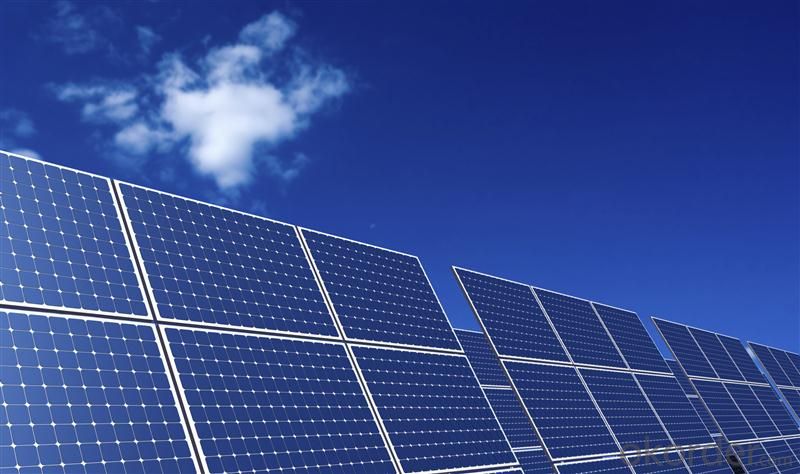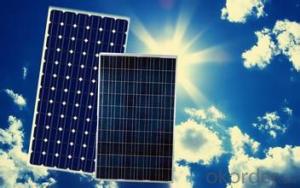100W CNBM Monocrystalline Silicon Panel for Home Using
- Loading Port:
- Tianjin
- Payment Terms:
- TT OR LC
- Min Order Qty:
- 100 watt
- Supply Capability:
- 1000 watt/month
OKorder Service Pledge
OKorder Financial Service
You Might Also Like
Item specifice
100W CNBM Monocrystalline Silicon Panel for Home Using
Production description
Emerging, third generation solar technologies use advanced thin-film cells. They produce a relatively high-efficiency conversion for the low cost compared to other solar technologies. Also, high-cost, high-efficiency, and close-packed rectangular multi-junction (MJ) cells are preferably used in solar panels on spacecraft, as they offer the highest ratio of generated power per kilogram lifted into space. MJ-cells are compound semiconductors and made of gallium arsenide (GaAs) and other semiconductor materials. Another emerging PV technology using MJ-cells is concentrator photovoltaics (CPV).

Feature
1.High conversion efficiencies resulting in superior power output performance.
2.Outstanding power output even in low light or high temperature conditions
3.Optimized design for ease of soldering and lamination
4.Long-term stability,reliability and performance
5.Low breakage rate
6.Color uniformaity
Physical characteristic
1. Rigorous quality control meets the highest international standards.
2. High-transmissivity low-iron tempered glass, strong aluminium frame.
3. Using UV-resistant silicon.
4. IS09001/14001/CE/TUV/UL
- Q:Can solar panels be used in areas with frequent power outages?
- Yes, solar panels can be used in areas with frequent power outages. Solar panels generate electricity from sunlight, so as long as there is sunlight available, they can continue to produce power even during power outages. Additionally, solar panels can be equipped with battery storage systems to store excess energy generated during the day for use during periods of low sunlight or power outages, making them a reliable source of electricity in areas with frequent power disruptions.
- Q:Can solar panels be used to power a factory?
- Yes, solar panels can be used to power a factory. By installing a sufficient number of solar panels on the factory's premises, the factory can generate enough renewable energy to meet its power requirements. This can help reduce reliance on traditional power sources and contribute to a more sustainable and eco-friendly operation.
- Q:Ok so i'm writing this research paper on why solar panels are the best way to quot;go greenquot;. I need at least 5-7 reasons why they are good. and a common counterargument that i could defend. I've already come up with incentives and efficiency but i need a few more Please help its very important and worth half my grade
- Actually, solar energy IS a good one. It's something we all need to think about, especially when coal and oil become harder to get. Good luck with your paper!
- Q:Can solar panels be installed on a sports stadium or arena?
- Yes, solar panels can be installed on a sports stadium or arena. In fact, many stadiums and arenas around the world have already installed solar panels to generate clean and renewable energy. These panels can be placed on the rooftop, parking structures, or even integrated into the façade of the building. Installing solar panels on sports stadiums and arenas not only helps in reducing carbon emissions and promoting sustainability but also saves on energy costs in the long run.
- Q:Can solar panels be installed on vehicles?
- Yes, solar panels can be installed on vehicles. They are commonly used on electric cars, boats, and recreational vehicles to harness solar energy and help charge their batteries.
- Q:Is it possible for the everyday person to increase the efficiency of solar panels that they own? If so, how is it done?
- If you have a way to keep silicon panels cool, that really helps. On a hot summer day, our array was down 20% in production. I sprayed a hose to wash the panels, and for a few minutes, the power spiked to 20% ABOVE normal. The usual thing to do is mount the panels exposed to the wind if you can, or at least 8 off the roof otherwise. A few lucky souls with access to free stream water on their property have been known to use water cooling under their panels.
- Q:Can solar panels be installed on a factory or industrial facility?
- Yes, solar panels can be installed on a factory or industrial facility. In fact, many factories and industrial facilities have started adopting solar energy as a renewable and sustainable source of power. Installing solar panels on such facilities can help reduce their carbon footprint, lower electricity costs, and provide a reliable source of clean energy.
- Q:The voltage and power problems of solar panels
- Because the MPPT controller has a wider input voltage range, it can also convert multiple voltages into current charge and better protect the battery.
- Q:How to make a simple solar panel?
- Making a solar electric (photovoltaic) panel is not a simple matter. You could make one up by wiring individual solar cells together, but it would either be more expensive than a panel you could just buy, or not very good. It's kind of like making your own TV. You could put one together from scratch if you really had to, but it wouldn't be worth it, when you can just go go Costco and get one cheaper.
- Q:i was told that by making a solar panel they cause more pollution than they will end up getting rid of. Is that true?
- Long ago, say, in the 960's, it was true that solar cells did not return the energy of their manufacture. In those days, cells were 4% efficient, and made with more material and a less efficient process. Unfortunately, the myth persists that this is still the case today from unaccredited sources. Kudos to Michael for the nrel link. That study was actually done over 0 years ago, and since then, technology has advanced even further. Manufacturers have been able to reduce the thickness of cells in general in the last decade, to use less crystalline silicon. Also manufacturers such as Suntech with their pluto process are now able to use a lower grade of silicon, that takes less energy to refine. The result is that the energy payback time is even shorter today than estimated in the linked paper.
1. Manufacturer Overview |
|
|---|---|
| Location | |
| Year Established | |
| Annual Output Value | |
| Main Markets | |
| Company Certifications | |
2. Manufacturer Certificates |
|
|---|---|
| a) Certification Name | |
| Range | |
| Reference | |
| Validity Period | |
3. Manufacturer Capability |
|
|---|---|
| a)Trade Capacity | |
| Nearest Port | |
| Export Percentage | |
| No.of Employees in Trade Department | |
| Language Spoken: | |
| b)Factory Information | |
| Factory Size: | |
| No. of Production Lines | |
| Contract Manufacturing | |
| Product Price Range | |
Send your message to us
100W CNBM Monocrystalline Silicon Panel for Home Using
- Loading Port:
- Tianjin
- Payment Terms:
- TT OR LC
- Min Order Qty:
- 100 watt
- Supply Capability:
- 1000 watt/month
OKorder Service Pledge
OKorder Financial Service
Similar products
New products
Hot products
Related keywords



























